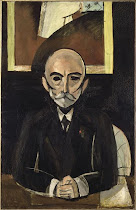Today, as I sat in an ice fishing hut, I watched a young, skilled fisherman use a sharp knife to slice up a pike and a walleye. He sat with a board on his lap as he went about his work in a casual and inviting manner. The two adults nodding with appreciation. The two children were riveted. The four-year old leaned in, inches from the face of the pike, straining to see it's teeth as the father held the mouth open.
When a fish is cleaned the head remains eerily untouched while the rest of its dismembered body stretches out in a sloppy pile. The skilled fisherman cut open the stomach to reveal the sucker minnow used as bait. The other child eagerly scooped it up in his hand.
Not once did the children shirk at the blood or ask a question about the death of the fish. They were content, as were the adults, smiling and eager as they palmed two more minnows from the bucket, pushing the hooks through their bodies and setting the fishing rod back in place.
Monday, February 21, 2011
Sunday, February 20, 2011
Hunger Games
I finished reading Hunger Games a while ago and I wanted to reflect on the author's (Suzanne Collins) use of violence. As I was reading the book I remember thinking that Collins' fight scenes seemed amateur. There was something about them that wasn't quite right. Later, I reflected on why her style seemed so unfamiliar to me.
In books like The Lord of the Flies, violence is portrayed as a force that is barely under the surface of civilization, waiting for its chance to boil up and over. The boys are sadistic and wild when left to their own devices. Similarly, the television series Spartacus depicts slaves forced to take part in the gladiatorial games. The characters show no reluctance once on the sand, easily tapping into their "inner monster" for scene after scene of computer animated throat slashing and decapitation.
What I came to realize about Hunger Games was that the author did not present violence as the beast that sleeps within us all. In Collins' story characters fight because of their relationships. All of these stories share the similarity of forcing their characters into a situation where there will be violent conflict. Collins' story proposes that people are most likely to be violent to protect the ones that they love. In contrast, the fiction written by male authors emphasizes the inevitability of the violent beast within us all. Is gender a useful category for analysis here? Are males trained to see violence as inevitable and females trained to see it as a last resort to protect our loved ones?
In books like The Lord of the Flies, violence is portrayed as a force that is barely under the surface of civilization, waiting for its chance to boil up and over. The boys are sadistic and wild when left to their own devices. Similarly, the television series Spartacus depicts slaves forced to take part in the gladiatorial games. The characters show no reluctance once on the sand, easily tapping into their "inner monster" for scene after scene of computer animated throat slashing and decapitation.
What I came to realize about Hunger Games was that the author did not present violence as the beast that sleeps within us all. In Collins' story characters fight because of their relationships. All of these stories share the similarity of forcing their characters into a situation where there will be violent conflict. Collins' story proposes that people are most likely to be violent to protect the ones that they love. In contrast, the fiction written by male authors emphasizes the inevitability of the violent beast within us all. Is gender a useful category for analysis here? Are males trained to see violence as inevitable and females trained to see it as a last resort to protect our loved ones?
Subscribe to:
Posts (Atom)



